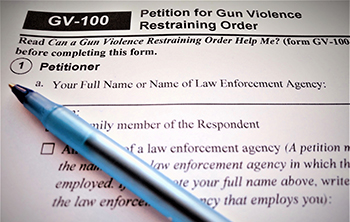Extreme risk protection orders, also known as gun violence restraining orders (GVROs) or "red flag" orders, exist in 19 states and the District of Columbia.
 Gun violence restraining orders, also known as extreme risk protective orders, can be effective tools for preventing violence.
Gun violence restraining orders, also known as extreme risk protective orders, can be effective tools for preventing violence.
The laws allow law enforcement, family and household members, some co-workers, employers and teachers to work with a judge to temporarily remove access to firearms and ammunition from people at significant risk of self-harm or harming others.
But an obstacle to implementing these preventive measures has been revealed in a new study from the Violence Prevention Research Program at UC Davis Health. Although GVROs have been available in California for five years, two-thirds of the Californians surveyed for the study had never heard of them.
"Firearm violence is preventable, not inevitable. Raising public awareness about proactive ways for people to intervene can be crucial for preventing violence before it occurs," said Nicole Kravitz-Wirtz, lead author of the study and an assistant professor with the Violence Prevention Research Program.
GVROs are only available if an individual has or could get a gun, and other options to protect against harm have failed or are not appropriate.
The study appears June 4 in JAMA Health Forum.
Majority, including gun owners, would be somewhat or very willing to use a GVRO
The survey was completed in July 2020 by 2,870 adults statistically representative of the adult population in California. It also assessed personal willingness to use a GVRO when a family member was at risk.
After reading a brief description of California's GVRO law, more than 80% of the respondents said they would be somewhat or very willing to ask a judge to issue a GVRO if a family member had threatened to physically hurt themselves, someone else or a group of people.
Respondents who lived in homes with gun owners expressed the highest levels of willingness to ask a judge for a GVRO. The responses ranged from 84% who were somewhat or very willing if a family member were experiencing an emotional crisis to 95% if a family member had threatened to physically hurt someone else.
The study included five risk scenarios of a person who has or could get a gun and:
- was experiencing an emotional crisis;
- has severe dementia or similar condition;
- has threatened to physically hurt themselves;
- has threatened to physically hurt someone else; or
- has threatened to physically hurt a group of people.
A majority of respondents who identified as gun owners — 70% to 86%, depending on the described risk scenario — said they would be somewhat or very willing to ask a judge for a GVRO if a family member had threatened to harm themselves or others.
About 30% of the respondents reported they were unwilling to ask a judge for a GVRO for a family member in at least one of the described risk scenarios. The most frequently cited reason for being unwilling was not knowing enough about GVROs. The second most common reason was the belief that the described risk scenarios are personal or family matters.
GVROs can be effective tools for preventing violence. They leverage the knowledge of those who are often the first to recognize someone they care about is in crisis or behaving dangerously and provide a tool for proactive intervention.
Prevention measures gaining traction in United States
Firearms are involved in half of suicides and three-quarters of homicides in the United States, accounting for nearly 39,000 violent deaths in 2019, the most recent year in which data are available from the Centers for Disease Control and Prevention.
Gun Violence Restraining Orders in California
A Gun Violence Restraining Order, or GVRO, is a civil court order in California that temporarily prevents a person who is at risk of hurting themselves or others from possessing or purchasing any firearms or ammunition.
California has three types of GVROs: emergency, temporary (also known as ex parte), and orders issued after notice and hearing. Emergency orders are available to law enforcement 24 hours a day for rapid response in crisis situations. Family members, household members, some co-workers and employers and law enforcement may petition for temporary orders and orders issued after notice and hearing.
The California Courts website has detailed information on how to ask for a GVRO in English and Spanish. Additional information is also available at speakforsafety.org.
Who can ask the court for a GVRO?






